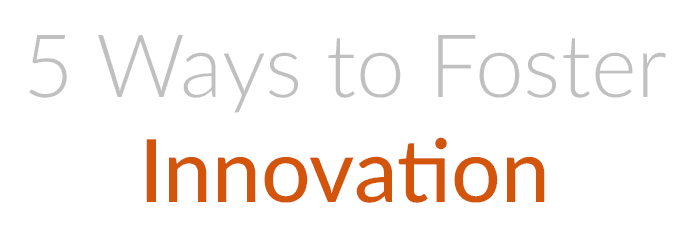The rise of the digital economy has made fast and continuous innovation a requirement of successful business. One truly innovative idea can bring down industry giants or disrupt an entire sector in only a few years, therefore all businesses must create structures which foster internal innovation. Here are my top 5 ways to understand and foster innovation in your company.
Agile Project Management
Born from the unpredictable world of software development about 15 years ago, Agile project management is one of the best way to unlock innovation and improve agility, particularly around product development. In Agile frameworks (of which there are a few), the traditional corporate hierarchy is flattened and information is able to flow up and down the chain of command rapidly. Agile teams aim to be cross-functional and self-organizing as they work in short sprints to accomplish chunks of a larger goal. As each chunk is accomplished, acquired information is diffused and the ultimate goal is re-calibrated based upon new information. New and highly relevant information will arise during development and shouldn’t have to painstakingly travel up and down the chain of command for development to continue.
We are currently engaged with a client that, until recently, had a reputation for not being able to deliver products in a timely fashion. We helped them adopt and maintain an Agile product development structure and the results have been overwhelmingly positive. A new product was delivered in just 26 weeks while a complete front and backend website overall is on track to be completed in under 20 weeks. These short turnaround times were previously impossible, Agile has helped the team work together efficiently and become more customer-centric.
Self Disruption
Apple is one of the largest and most successful companies in history because over the past 20 years, they haven’t let others disrupt their business…they disrupted themselves. Apple has consistently developed and released self-cannibalizing products and services, undermining their own market with a more versatile solution. In a 2013 quarterly earnings call Tim Cook said:
“I see cannibalization as a huge opportunity for us. Our core philosophy is to never fear cannibalization. If we don’t do it, someone else will. We know that iPhone has cannibalized some of our iPod business. That doesn’t worry us. We know that iPad will cannibalize some Macs. But that’s not a concern. On iPad in particular, we have the mother of all opportunities because the Windows market is much, much larger than the Mac market. It is clear that it is already cannibalizing some. I still believe the tablet market will be larger than the PC market at some point. You can see by the growth in tablets and pressure on PCs that those lines are beginning to converge.”
When working with clients to improve their innovation capabilities, I like to start with an exercise that fosters an outside-in mindset crucial for self-disruption. Divide your leadership team into small, cross-functional groups and ask them to write out a business plan for startup whose main goal is to disrupt your company. What would it produce? How would it be structured? Then take the best ideas and use them to begin development on self-disruptive products or services. We find that this exercise helps companies think differently and not get trapped by current company limitations.
Creative Abrasion
In an article for the Harvard Business Review, Professor Linda A. Hill notes,
“New and useful ideas emerge as people with diverse expertise, experience, or points of view thrash out their differences. The kind of collaboration that produces innovation is more than a simple ‘get-along’ cooperation. It involves and should involve passionate discussion and disagreement.”
I agree with her 100%. Innovation relies upon creating teams where progressive sparks and tension can exist, as each team member approaches a problem with their own expertise (and cognitive biases) the rest of the team gains new perspective. Team members should be ready to address hard push-back, for it is in the fray that innovation is born.
An example of this is Jeff Bezos’s approach at Amazon, which has been well-chronicled in the past few months. According to Brad Stone, Author and Chronicler of Amazon’s rise, “Bezos can’t stand social cohesion, the cloying tendency of people who like to agree with each other and find consensus comfortable.” Bezos and Amazon have remained innovation by fostering an atmosphere of creative abrasion. Of course, creative abrasion and challenging consensus cannot come at the expense respecting one’s co-workers and overall company morale.
Local vs Global
The digital economy is a global economy but it’s also about the cross pollination between local and global. Business innovation relies upon a careful calibration of roles and responsibilities from the micro to the macro. Local teams should make local decisions and suggest local innovations but there should always be a flow of information between local and the global hierarchy. On a practical level, that means managers who navigate the local and global, acting as a go-between. McDonalds self-service kiosks are a great example of local innovations being tested and later distributed globally. First introduced in smaller European markets, the self-service kiosk aims to provide a quicker and more customizable customer experience. Certainly an innovation! The nimbler local markets set the tone for how the kiosks have been introduced globally.
Scenius
Scenius, combining scene and genius, is a term coined by the famous musician, artist, and producer Brian Eno. It refers to the collective genius found among scenes. I believe that this term cuts to the core of how to foster innovation in your company or organization. Eno writes,
“I was an art student and, like all art students, I was encouraged to believe that there were a few great figures like Picasso and Kandinsky, Rembrandt and Giotto and so on who sort-of appeared out of nowhere and produced artistic revolution. As I looked at art more and more, I discovered that that wasn’t really a true picture. What really happened was that there was sometimes very fertile scenes involving lots and lots of people – some of them artists, some of them collectors, some of them curators, thinkers, theorists, people who were fashionable and knew what the hip things were – all sorts of people who created a kind of ecology of talent. And out of that ecology arose some wonderful work.”
Now, I wouldn’t call Silicon Valley or Silicon Alley diverse scenes but they certainly have Scenius as there is an “ecology of talent” driving innovation. Other scenius facilitators are social networks, internal communication tools like Slack, and analog ideas like open floor office plans. All help to create a churning conversation amongst engaged and creative people.
















